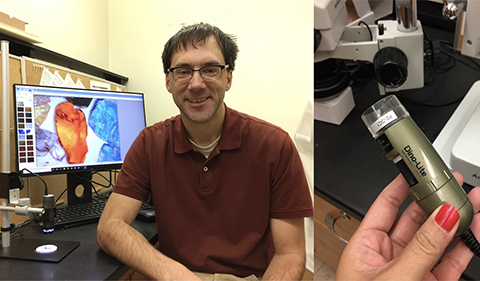
Dr. Anthony Stender with a close up of the USB microscope
By Ling Xin
NQPI Editorial Intern
Nanoscale and Quantum Phenomena Institute 2019 Fall Newsletter
Analytical chemist Dr. Anthony Stender pointed a green-color, palm-sized microscope at some crystal samples and pressed the capture button. As the microscope was connected to a desktop via a USB plug, an image of the crystals’ fine texture popped up on the screen in no time.
Microscopes play an essential role in forensic chemistry, said Stender, an assistant professor of Chemistry and Biochemistry at Ohio University and member of the Nanoscale and Quantum Phenomena Institute (NQPI). However, traditional microscopes are bulky and expensive. Thanks to the advancement of digital camera technology, simple and portable microscopes are getting popular over the past five years. These so-called USB microscopes come with light sources and their own camera, and can be pointed at any angle to image almost any material. They are also more affordable, ranging from hundreds to a few thousands of dollars.
As such, these devices appear to be an ideal candidate to incorporate in a classroom and give students access to high technology instrumentation. Stender decided to give them a try. Last year, he purchased two USB microscopes for his microscopy class.
To find out whether these microscopes are capable of imaging at a level sufficient for forensic requirements as the manufacturer had claimed, Stender’s group compared their imaging performances against those of more expensive, traditional microscopes. Using a variety of forensic samples including dollar bills, colored threads, and cotton fibers, they concluded that the USB microscopes are a reasonable option for basic imaging of objects larger than 10 micrometers in the near-ultraviolet, visible, and near infrared.
“Our findings are interesting because the USB microscopes actually do quite well at low magnifications,” said Stender. Although they do not share the same level of resolution and image quality as the most sophisticated optical microscopes, the USB microscopes performed as well as a traditional stereomicroscope currently used in his lab.
Chemistry graduate student Rachel Bracker worked with Stender on collecting the images and writing the paper. Details of their study, which are among the first performance tests on USB microscopes so far, have been reported in Forensic Science International with the title Technical Note: Efficacy of USB Microscopes for Imaging Forensic Materials.
Stender plans to use the USB microscopes for his microcopy class in the future because they are very user-friendly. Students can simply take them outside and point them at anything during field work. “I’m surprised to see how handy and powerful USB microscopes can be,” he said. “Although we can’t use these microscopes for studying nanoscale materials, we were pleased with their ability to image larger scale objects, which makes them an ideal tool for hands-on undergraduate research.”


















Comments